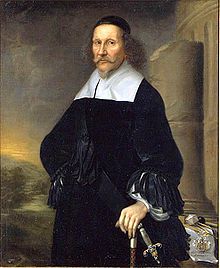Georg Stiernhielm

Georg Stiernhielm (born August 7, 1598 in Vika , Dalarna , Sweden , † April 22, 1672 in Stockholm ) was a Swedish poet , lawyer, linguist and mathematician .
Life
Stiernhielm came from a family of miners and was born Göran Olofsson , later he was also called Lilia . He studied in Uppsala at the Rudbeckius Kollegium and in Germany, including at the University of Greifswald .
Coming from a humble background, he made a career in the administration of the Swedish state and was among other things a judge in Dorpat in Livonia and head of the Swedish Imperial Archives. He also worked as a linguist and mathematician. In 1631 he was ennobled and took the name Georg Stiernhielm . On December 9, 1669 he was elected a member ( Fellow ) of the Royal Society .
meaning
Stiernhielm is known as the "father of Swedish poetry". He tried to establish a Swedish poetry by translating the ancient meter into Swedish . In place of the sequence of long and short syllables in ancient languages, he put the sequence of stressed and unstressed syllables. He also endeavored to create a Swedish that was as pure as possible and freed from foreign influences.
Stiernhielm's most important work is Hercules , the story of Hercules at the crossroads , who has to choose between pleasure and virtue. Stiernhielm's Hercules is a hexameter epic based on ancient models. Stiernhielm proved that the classic hexameter can also be used well in Swedish:
- Hercules arla stod vpp, en Morgon, i första sin Vngdom
- Fuller af Ångest, och twijk, huru han sitt Lefwerne böria
- skulle, däraf han pris customer vinna, medh Tijden, och Ähra ...
-
- (Hercules got up early one morning in his early youth
- full of fear and doubt as to how he will begin his life
- should, so that in time he would gain recognition and honor ...)
Hercules is an artfully worked through work full of baroque imagery and powerful rhetoric.
In addition, Stiernhielm wrote various other poetry, in particular "Ballets", that is, rhymed explanations and contents of ballets that were performed at the royal court.
The hexameter poem Bröllops beswäres Ihugkommelse is also handed down under Stiernhielm's name , but in view of the burlesque realism, which is untypical for Stiernhielm, the attribution is questionable.
Stiernhielm founded the tradition of the Swedish hexameter poetry, in which Esaias Tegnér , Johan Ludvig Runeberg and August Strindberg created their own works. The latter known in his poem Trefaldighetsnatten (Die Trinitatisnacht, second version 1905):
- The end of the noise is clear from the front of the fader
- Stiernhielm som först and somebäst har sjungit på renaste svenska
- Uti hexameters gång, the sexfota klassiska verses.
-
- (I am only an apprentice to the worthy father of our poetry
- Stiernhielm, who was the first and the best to sing in the purest Swedish
- in hexameters, the classic six-footed verse)
literature
- Bernt Olsson, Ingemar Algulin: Litteraturens historia i Sverige . 4th edition. Norstedt, Stockholm 1995, ISBN 91-1-943632-7 .
- Göran Hägg: Den svenska literaturhistorien . Wahlström & Widstrand, Stockholm 1996, ISBN 91-46-16928-8 .
Web links
Individual evidence
- ^ Entry on Stiernhielm, Georg (1598 - 1672) in the archive of the Royal Society , London
| personal data | |
|---|---|
| SURNAME | Stiernhielm, Georg |
| BRIEF DESCRIPTION | Swedish poet, lawyer, linguist and mathematician |
| DATE OF BIRTH | August 7, 1598 |
| PLACE OF BIRTH | Vika , Dalarna , Sweden |
| DATE OF DEATH | April 22, 1672 |
| Place of death | Stockholm |